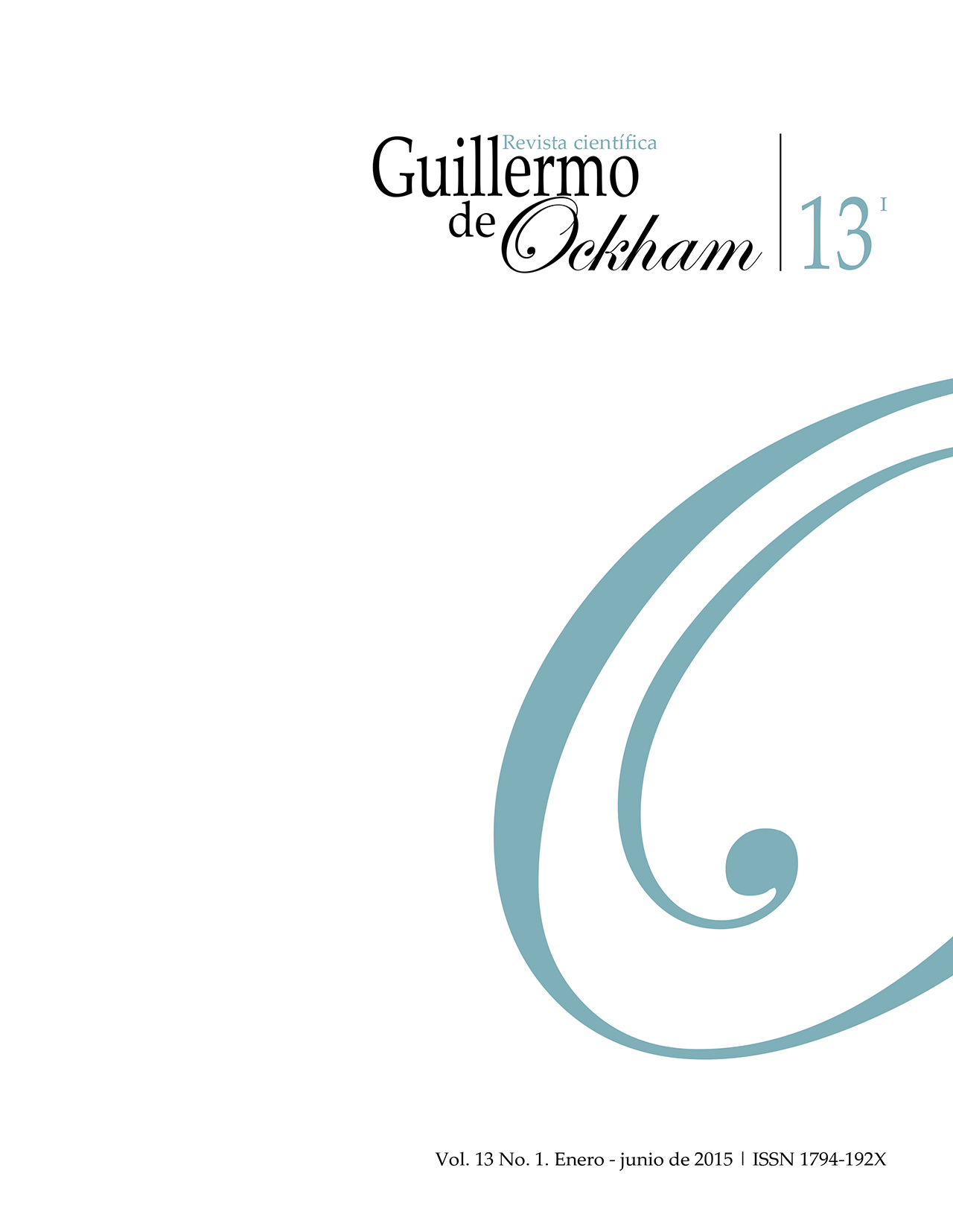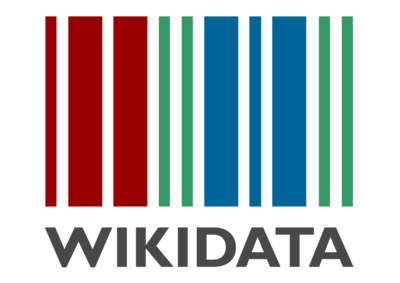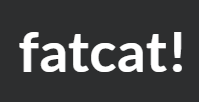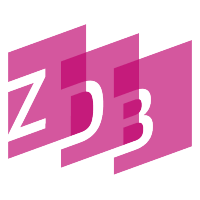The Revista Guillermo de Ockham provides an immediate and open access to its content, based on the principle of offering the public a free access to investigations to provide a global interchange of knowledge.
Unless otherwise established, the contents of this journal has a license with Creative Commons Attribution-NonCommercial-NoDerivatives 4.0 International (CC BY-NC-ND 4.0) http://creativecommons.org/licenses/by-nc-nd/4.0/
- Attribution: You must give appropriate credit, provide a link to the license, and indicate if changes were made. You may do so in any reasonable manner, but not in any way that suggests the licensor endorses you or your use.
- NonCommercial: You may not use the material for commercial purposes.
- NoDerivatives: If you remix, transform, or build upon the material, you may not distribute the modified material.
- No additional restrictions: You may not apply legal terms or technological measures that legally restrict others from doing anything the license permits.
Resumo
The study reported in this paper focuses on the use of Genre Theory as an appropriate framework for English L2 writing in the subject English Language III of the degree course in English Studies. We analysed 115 recounts written by students on this course at the University of Alicante (Spain) after they had studied different text types following Genre Theory. This Theory was applied in order to increase students’ literacy skills through the study of text types and specific grammatical characteristics that appear in these texts. This study will show that using the Theory of Genre as a framework to teach academic writing helped students to improve their writing skills. The results of the texts analysed suggest that exposing students to good models of different text types, paying special attention to recounts, and asking them to write texts based on these models, improves students’ texts from the grammatical and the textual point of view.
Referências
Butt, D., Fahey, R., Spinks, S. , & Yallop, C. (2000). Using Functional Grammar. An Explorer’s Guide. Second edition. Sydney: NCELTR.
Carrasquillo, A. L., & Rodríguez, V. (2008). Language Minority Students in the Mainstream Classroom. Bristol: Multilingual Matters.
Coffin, C. (2001). Theoretical approaches to Written Language: A TESOL Perspective. In A. Burns & C. Coffin (Eds.), Analysing English in a Global Context. A Reader (pp. 93-122). London: Routledge.
Coffin, C., & Donohue, J. P. (2012). Academic Literacies and systemic functional linguistics: How do they relate? Journal of English for Academic Purposes, 11, 64-75.
De Sylva Joyce, H., & Burns, A. (1999). Focus on Grammar. Sydney: NCELTR.
Droga, L., & Humphrey, S. (2003). Grammar and Meaning. An Introduction for Primary Teachers. Berry NSW: Target Texts.
Drury, H. (2004). Teaching academic writing on screen: a search for best practice. In R. Ellis & J.L. Ravelli (Eds.), Analysing Academic Writing. Contextualised Frameworks (pp. 233-253). London: Continuum.
Edelsky, C. (2006). Literacy and Justice for All: Rethinking the Social in Language and Education (Language, Culture, and Teaching). NY: Lawrence Erlbaum Associates.
Fairclough, N. (2003). Analysing Discourse. Textual Analysis for Social Research. London: Routledge.
Fang, Z., & Schleppegrell, M. J. (2010). Disciplinary literacies across content areas: Supporting secondary reading through functional language analysis. Journal of Adolescent & Adult Literacy, 53, 587-597.
Fecho, B. (2011). Teaching for the Students. Habits of Heart, Mind, and Practice in the Engaged Classroom. N Y: Teachers College Press.
Fenstermacher, G. D., & Soltis, J. F. (2009). Approaches to Teaching. NY: Teachers College Press.
Gardner, S. (2012). Genres and registers of student report writing: An SFL perspective on texts and practices. Journal of English for Academic Purposes, 11, 52-63.
Halliday, M. A. K (1978). Language as Social Semiotic: The Social Interpretation of Language and Meaning. London: Edward Arnold.
Hasan, R. (1984). The Nursery Tale as a Genre. Nottingham Linguistic Circular, 12, 71-102.
Hasan, R. (1989). The structure of the text. In M. A. K. Halliday & R. Hasan Language, Context, and Text: Aspects of Language in a Social-Semiotic Perspective (pp. 52-69). Oxford: Oxfords University Press.
Herrington, A., Hodgson, K., & Moran, C. (Eds.) (2009). Teaching the New Writing. Technology, Change and Assessment in the 21st Century Classroom. NY: Teachers College Press.
Hsien-Chin, L. (2000). Assessing Learner Strategies Using Computers: New Insights and Limitations. CALL, 13(1), 65-78.
Hua, Z., Seedhouse, P, Li, W., & Cook, V. (2007). An Introduction. In Z. Hua, P. Seedhouse, W. Li & V. Cook (Eds.), Language Learning and Teaching as Social Inter-action (pp. 1-5). London: Palgrave Macmillan.
Hubbard, P., & Levy, M. (2006). The scope of CALL education. In P. Hubbard & M. Levy (Eds.), Teacher Education in CALL (pp. 3-20). Amsterdam/Philadelphia: John Benjamins.
Klein, P., & Unsworth, L. (2014). The logogenesis of writing to learn: A systemic functional perspective. Linguistics and Education, 26, 1-17.
Klein, P. D., & Yu, A. M. (2013). Best practices in writing to learn. In S. Graham, C. A. MacArthur, & J. Fitzgerald (Eds.), Best practices in writing to learn. Second edition. (pp. 166-189). NY: The Guilford Press.
Kress, G. (2003). Literacy in the New Media Age. London: Routledge.
Martin, J. R., & Rose, D. (2012). Learning to Write/Learning to Learn: Genre, Knowledge and Pedagogy in the Sydney School. London: Equinox.
Martínez-Lirola, M. (Abril, 2005). How to highlight context in academic writing from a SFL perspective. Trabajo presentado en la I Conferencia Regional Latinoamericana de Lingüística Sistémica Funcional. Mendoza, Universidad Nacional de Cuyo-Argentina.
Martínez-Lirola, M. (2006). The importance of teaching Systemic Functional Linguistics and Text Linguistics to improve writing in Bilingual Education Programs in the USA. Porta Linguarum. Revista Internacional de Didáctica de las Lenguas Extranjeras, 5, 139-150.
Martínez-Lirola, M. (2007). El nuevo papel del profesor universitario en el proceso de convergencia europeo y su relación con la interacción, la tutoría y el aprendizaje autónomo. Porta Linguarum. Revista Internacional de Didáctica de las Lenguas Extranjeras, 7, 31-43.
Martínez-Lirola, M. (2013). Teaching visual grammar and social issues in an English language course: an example using multimodal texts on immigrant minors from a Spanish newspaper. In F.J. Díaz- Pérez, M.B. Díez-Bedmar, P. García-Ramírez & D. Rascón-Moreno (Eds.) Global Issues and the Teaching of Language, Literature and Linguistics (pp. 195-215). Viena: Peter Lang.
Martínez-Lirola, M., & Tabuenca Cuevas, M. (2008). Integrating CALL and Genre Theory: a Proposal to Increase Students’ Literacy. RECALL, 20(1), 67-81.
Martínez-Lirola, M., & Tabuenca-Cuevas, M. (2010). Applying Genre Theory to improve exposition-type essay writing. Revista Internacional de Didáctica de las Lenguas Extranjeras, 13, 29-42.
Moyano, E. I. (2013). (coord) Aprender Ciencias y Humanidades: una cuestión de lectura y escritura. Aprotes para la construcción de un programa de inclusión social a través de la educación lingüística. Buenos Aires: Universidad Nacional de General Sarmiento.
Parodi, G. (2010). Written discourse genres. Towards an integral conception from a sociocognitive perspective. In G. Parodi (Ed.), Academic and Professional Discourse Genre in Spanish (pp. 17-35). Amsterdam-Philadelphia: John Benjamins.
Pérez-Gutiérrez, M., & Pérez- Torres, I. (2005). Audio-visual resources and new technologies in ELT. In D. Madrid, N. Mclaren & A. Bueno (Eds.), TEFL in Secondary Education (pp. 545-578). Granada: Universidad de Granada.
Trofimovich, P., & McDonough, K. (Eds.) (2011). Applying Priming Methods to L2 Learning, Teaching and Research. Insights from Psycholinguistics. Amsterdam-Philadelphia: John Benjamins.
Schleppegrell, M. J. (2011). Supporting disciplinary learning through language analysis: Developing historical literacy. In F. Christie, & K. Maton (Eds.), Disciplinarity: Functional linguistic and sociological perspectives (pp. 197-216). London: Continuum International Publishing Group.
Swales, J. M. (2002). On models of applied discourse analysis. In C.N. Candlin (Ed.), Research and Practice in Professional Discourse (pp. 61-77). Hong Kong: City University of Hong Kong Press.
Wennerstrom, A. (2003). Discourse Analysis in the Language Classroom. Volume 2. Genres of Writing. Michigan: The University of Michigan Press.
Wingate, U. (2012). Using Academic Literacies and genre-based models for academic writing instruction: A ‘literacy’ journey. Journal of English for Academic Purposes, 11, 26-37.































